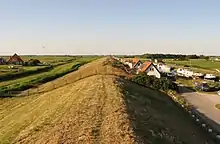Sleeper dike
A sleeper dike (in Dutch slaperdijk) is a dike which does not normally face water, but serves as a backup if a "front-line" dike in front of it breaks.

The sleeper dikes are usually located at places where there is a high risk of dike breakthrough or where there used to be such a risk.[1] The dike is only potentially safeguarding the land from the sea/river, and is "sleeping", hence the name. Sometimes there is even a secondary sleeper dike, which can be called a "dreamer dike".[2]
Many of the sleeper dikes are historical, and no longer have a function in protection against the water, after the dike improvements of the Delta Plan. However, in case of a breakthrough they do divide up the land in sections, and therefore stop the waterflow in some parts, and slow down in others. Also many of these dikes are protected because of their cultural historical and ecological value.
References
- Marijnissen, Richard J. C.; Kok, Matthijs; Kroeze, Carolien; van Loon-Steensma, Jantsje M. (2021-08-01). "Flood risk reduction by parallel flood defences – Case-study of a coastal multifunctional flood protection zone". Coastal Engineering. 167: 103903. doi:10.1016/j.coastaleng.2021.103903. ISSN 0378-3839. S2CID 236344853.
- Fisher, Jim (1991-12-22). "THE SEA RAGES, BUT THE DUTCH KEEP HEADS ABOVE WATER". The Lewiston Tribune. Retrieved 2023-09-14.